The NVIDIA GeForce GTX 1650 Review, Feat. Zotac: Fighting Brute Force With Power Efficiency
by Ryan Smith & Nate Oh on May 3, 2019 10:15 AM ESTFinal Fantasy XV (DX11)
Upon arriving to PC earlier this, Final Fantasy XV: Windows Edition was given a graphical overhaul as it was ported over from console, fruits of their successful partnership with NVIDIA, with hardly any hint of the troubles during Final Fantasy XV's original production and development.
In preparation for the launch, Square Enix opted to release a standalone benchmark that they have since updated. Using the Final Fantasy XV standalone benchmark gives us a lengthy standardized sequence to utilize OCAT. Upon release, the standalone benchmark received criticism for performance issues and general bugginess, as well as confusing graphical presets and performance measurement by 'score'. In its original iteration, the graphical settings could not be adjusted, leaving the user to the presets that were tied to resolution and hidden settings such as GameWorks features.
Since then, Square Enix has patched the benchmark with custom graphics settings and bugfixes to be more accurate in profiling in-game performance and graphical options, though leaving the 'score' measurement. For our testing, we enable or adjust settings to the 'Highest', 'High', or 'Medium' options except for NVIDIA-specific features and 'Model LOD', the latter of which is left at standard. For High, we also turn off the hi-res assets, while for Medium we also turn off 'Geomapping' (terrain tessellation). Final Fantasy XV also supports HDR, and it will support DLSS at some later date.
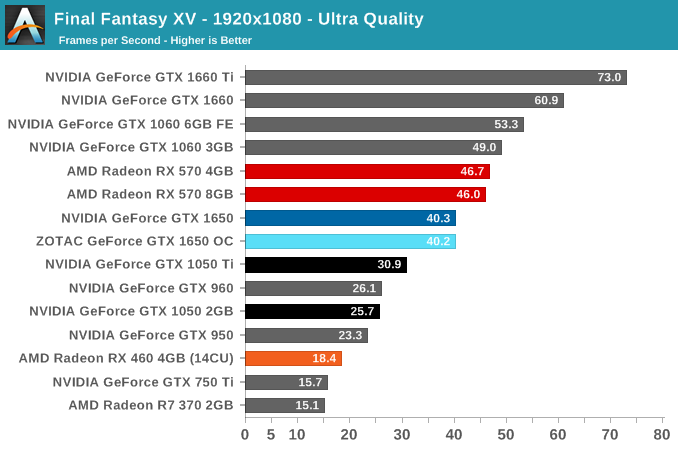
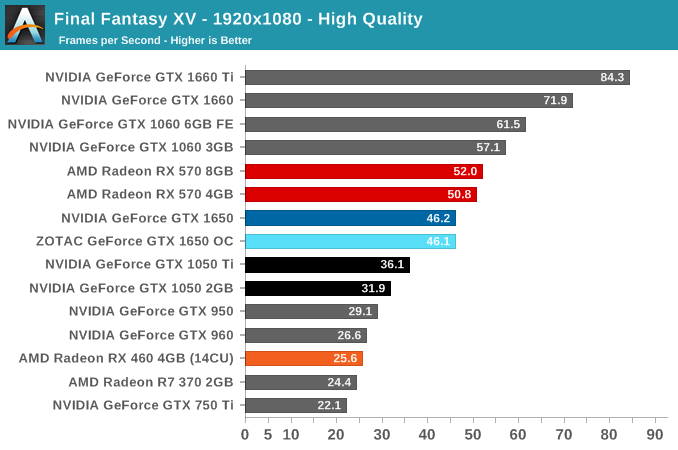
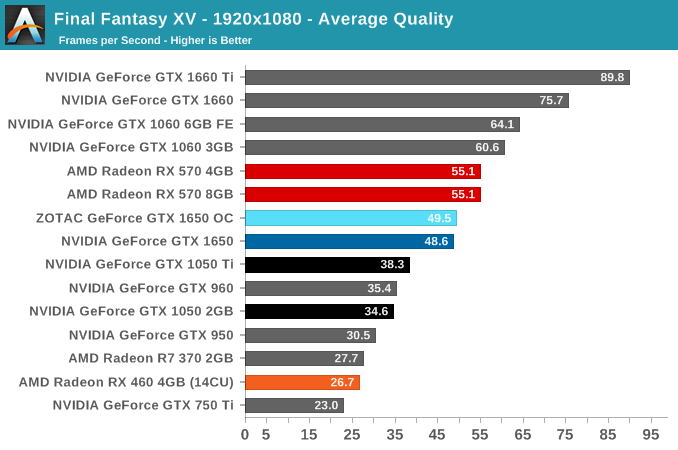
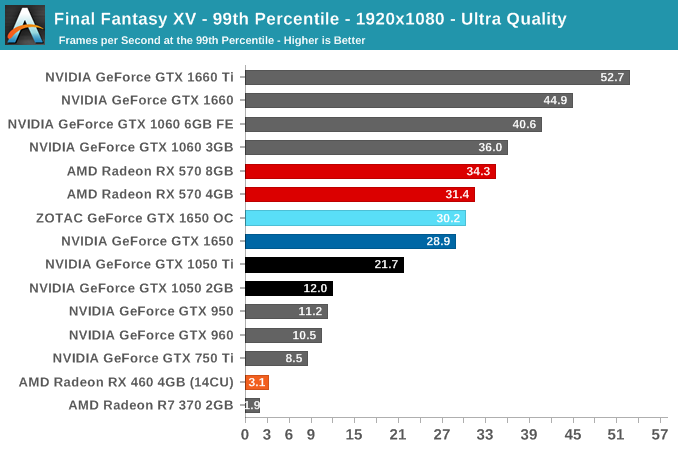
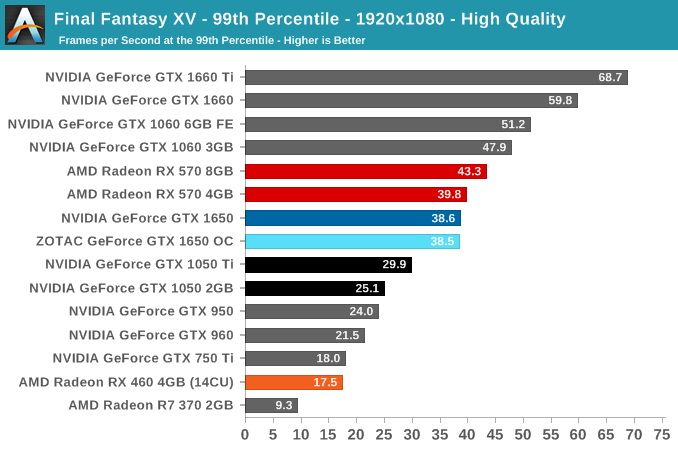
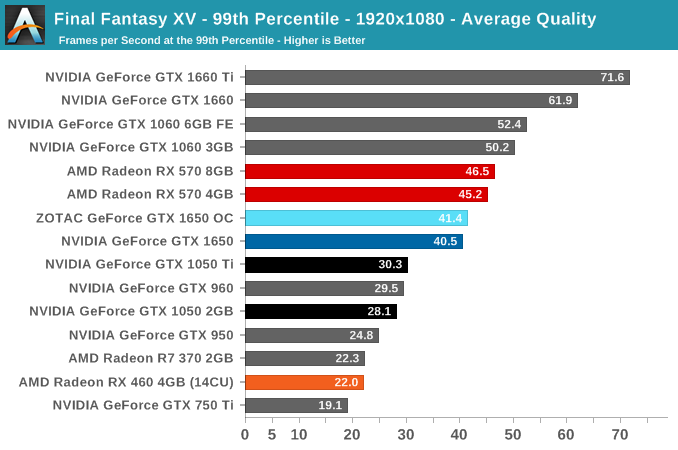
Final Fantasy V is another title that tends to prefer more VRAM, and with ultra settings and high-res textures, all the 2GB cards drop off in their 99th percentiles, reflecting the stuttering experience. The GTX 1650 is almost on par with RX 570 here at the higher settings.











126 Comments
View All Comments
nevcairiel - Saturday, May 4, 2019 - link
A P-Frame (Predictive Frame) by definition is only in one direction - backwards. B-Frames (Bidirectional Predictive Frame) are allowed in both directions. This is an import distinction because it matters in which order those frames are put into the encoded video. "Future" frames of course need to be send first, or you can't use them for prediction.Thats where pattern like "IPBBB" come from. You start with a single I frame, a single P frame referencing that I frame (the P might be shown after some B frames), and then an array of B frames that reference both the I and P frames - and possibly each other.
P and B frames are otherwise identical in how they work. Both contain motion vectors and entropy data to correct the interpolation.
Also note that H264 already supported up to 16 reference frames for interpolation. Its called bidirectional not because its two frames, but two directions - past and future.
Opencg - Friday, May 3, 2019 - link
please include fortnight average fps over 10 hour playtime. for all cards. all on the same patch. thxBulat Ziganshin - Friday, May 3, 2019 - link
The "NVIDIA is holding back a bit" part is duplicated on pages 1 and 2Ryan Smith - Friday, May 3, 2019 - link
Whoops. That was meant to get excised when I rearranged the article. Thanks!eva02langley - Friday, May 3, 2019 - link
This card shouldn't exist.R7 was making sense because it was cheaper than a 2080, however this is more expensive than a RX 570... AND WEAKER!
Oxford Guy - Saturday, May 4, 2019 - link
It apparently exists for the GTX 960 buyers (the people who don't do their homework).eek2121 - Friday, May 3, 2019 - link
In before 1650ti. ;)AshlayW - Friday, May 3, 2019 - link
Wow. This card makes no sense. Go watch hardware unboxed's video where he conveniently shoots down the "power efficiency" argument. It's a load of rubbish, there is absolutely no reason to buy this card over even the 4GB 570, for any new gaming build. This review tried so hard to paint this turd in a positive light, continually underscoring AMD's "technological disadvantages" and "thin profit margin". P20 isn't even that much bigger than TU117 also.I'm sorry I just feel it is too friendly to nvidia and doesn't criticize this terrible product pricing enough. RX570 8GB pulse, fro sapphire is cooler running, quieter, vastly higher build quality, >10% faster, twice the vram and 135W board power, which is perfectly fine even for potato OEM builds anyway.
Seriously, drop Ty efficiency arguy. This card is DOA at 149 because 570 killed it.
1024 CC card at 130 bucks would've been passable, not this joke.
AshlayW - Friday, May 3, 2019 - link
The 570 8Gb pulse is also the same price or cheaper than 1650, at least here in the UK. Forgot to mention that important point.AshlayW - Friday, May 3, 2019 - link
Typos as I'm on my phone and I have fat fingers.Should read: "drop the efficiency argument"